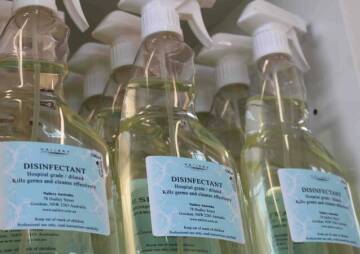-
Category
Craniomaxillofacial Surgery
Orthopedic Surgery
Spine Surgery
Orthopedic Implants
Hip Surgery
Knee Surgery
Pectus Excavatum
Bone Graft
Disinfectants
Healthcare
Different Types of Disinfectant Solutions in the Hospital

According to the Health Research and Quality Agency, infections are the most common problem among people being treated in hospitals. In this article, the types of disinfectant solutions in the hospital, the best and newest ones and the application of each are discussed.
According to the report announced by the Agency for Healthcare Research and Quality (AHRQ), infections are well known as the most common problem among people being treated in hospitals. In this research, several types of antiseptic solutions in the hospital, the best and newest ones, and their application are described.
According to the report announced by the Agency for Healthcare Research and Quality (AHRQ), infections are well known as the most common problem among people being treated in hospitals. In this regard, based on some experts, about 15 to 20 percent of nosocomial infections are suspended in the air. Regarding this issue and the high risk of infections and viruses for patients in all hospitals, they should consider restraining and controlling such infections through antiseptic solutions. Here, despite the advancement of science and the high risk of infections, do you believe that the use of antiseptic solutions is the same as before in hospitals should? Can newer materials be found to cope with the spread of infectious diseases in hospitals? Today, the use of antiseptic solutions has become an integral part of modern human life. Now, suppose there is a discussion about the use of disinfectant solutions in the hospital. In that case, it is critical to take a more serious decision. This is because the local hospital is sensitive and vital for all types of patients suffering from various diseases and illnesses, especially those that may be contagious or have little resistance to microbes. In this matter, there are some places in hospitals such as the operating room, ICU, and CCU, which are a part of the intensive care unit and should be safer and more disinfected than other hospital places.
Therefore, this research introduces several types of antiseptic solutions in the hospital, the best and newest ones, and their application in the following.
Types of disinfectants in the hospital
Disinfectants are the materials utilized on inanimate surfaces to kill pathogens. It is worthwhile to mention that the disinfectants do not sterilize the object, based on which it cannot kill all microbes. Disinfectants are classified into two categories, as follows:
- Physical: heat, drying, use of cold, radiation, or irradiation
- Chemical: aldehyde, gaseous chemical sterilizers, acids, formaldehyde, alcohols, phenols, and its derivatives
After expressing the use of disinfectants, some of the most popular and widely used disinfectants are demonstrated in hospitals as follows:
- Steranios: Disinfection of rangoscope heat resistant tool
- Lantern: Disinfection of floor surfaces
- 50AF Deconex: Disinfection of floor surfaces
- Deconex 53 Pulse: Tool Disinfection
- DD1 Aniosym: Disinfection tool
- Quick-acting micro-spray: Disinfection of surfaces
- Vitex 5%: Disinfection of surfaces and equipment
List of hospital disinfectants
One of the most critical factors to control infections in hospitals is using disinfectant solutions in the hospital. It should be noted that these solutions have a substantial role in killing microbes and viruses than disinfectants. In the following, the best and most famous disinfectant solutions in the hospital are provided.
- Disinfection with sodium hypochlorite in the hospital environment: it follows a significant effect to decrease infection as well as to prevent them, leading to inhibition of the growth of microorganisms
- Hydrogen peroxide: It decreases the contamination resulted from the multidrug-resistant pathogens on soft surfaces such as the bedside curtains
- Electrolyzed water: It can significantly decrease aerobic bacteria and C. difficile spores without leaving any toxic residue on surfaces.
- Atmospheric pressure plasma: They contain antibacterial activity against several pathogens.
- Nano-silver disinfectant: A new non-alcoholic product containing the antifungal properties
- Decospet: One of the most famous hand sanitizers
- Septic scrub: The scrub is utilized before the surgeon and the operating room staff's operation.
- Betadine (Povidone Aydin 10%): It is fruitful for disinfecting the skin, the second and third-degree burns, disinfecting the injection site, and preventing infection in sutures and dressings.
Surface antiseptic solution
The antiseptic solution contains those substances that affect living tissue and then cleanses it from microbes, infections, destructive and harmful agents. The terms of living tissue refer to the skin of the human body and living things. These substances kill bacteria and prevent them from growing by affecting bacteria, viruses, and fungi. Now, regarding the mentioned definition of disinfectant substances in the previous discussions, it can be said that the antiseptic solutions in the hospital for surfaces are those substances that affect the surfaces, in which the difference with disinfectants is that they can prevent growing, expansion, and transmission of bacteria and infections on surfaces through employing them better. Of course, it can also be said that these materials can be divided into two categories, as follows:
- Antimicrobials: Substances for killing microbes
- Bacterial inhibitors: Substances for inhibiting the microbe activities
Of course, it can be said that during the spread of infectious diseases such as influenza, especially the newest ones that are the coronavirus, the use of soap and water alone does not cope with the dangerous and mysterious coronavirus. As such, more antiseptic solutions should be utilized for both home and hospital use. As a result, this issue makes more of these solutions needed to heal faster and protect the environment of patients and even healthy people from infections and viruses. In this way, 20 liters disinfectant fluids are a suitable suggestion for the use in the cases of infectious diseases, at home, and even in hospitals. This amount of antiseptic liquid is an excellent response to the requirements of medical centers, health, office, and even home use in crisis times and the spread of infectious diseases.
Hospital hand antiseptic solution
The main application of antiseptic substances is on living tissues. The hospital hand antiseptic solutions are another type of hospital antiseptic solution. It should be noted that this solution could also be considered as an appropriate alternative for washing hands with soap and water and could be utilized as a supplement. Nevertheless, such solutions are more significant than using soap and water in the hospital during the spread of infectious viruses such as Corona. Different types of hand antiseptic solutions are produced in the form of foam, gel, and liquid solution. Most hand antiseptic solutions are created from isopropyl alcohol, ethanol, 1- propanol, or povidone-iodine. Other substances can also be employed in polyacrylic acid, glycerin, propylene glycol, and essential oil. Today's new substances with more capabilities are used to produce these solutions, in which one of the best and latest of them is introduced in the following.

Hand sanitizer standard:
According to the middle of the World Health Organization, the compounds in antiseptic solutions and their amount are as follows:
Alcohol-based gels and foams: Containing between 60-90% (v/v) ethanol and formulations, used to disinfect hands. Moreover, using a hand sanitizer containing 75% isopropanol or 80% ethanol is suggested in some of the WHO studies.
Non-alcoholic antiseptic solution
Because of the high use of alcohol in hospitals and health uses, most people consider alcohol a substantial and integral substance in producing antiseptic solutions. Of course, regarding the advancement of technology and medical science and chemistry, it can be said that scientists and researchers have come to the aid of alcohol through producing a new non-alcoholic antiseptic solution.
The emergence of silver nanoparticles
As you know, nanoscience in the industry brought a new era in industrial production and its products. With the introduction of nanosilver antiseptic solution, we conclude that this is practical science is useful and unique in the medical science and production of medical materials and equipment. The nanosilver product is one of the latest non-alcoholic antiseptic solutions in the hospital. This product contains the antifungal property that can kill bacteria better and more safely than other antiseptic solutions. This non-alcoholic antiseptic solution's antifungal property is that it is resistant to ringworms, which kill them well. In the past, nanosilver had served medical science in another form and name. Colloidal silver, which is the same silver with different concentrations and particle sizes, had been employed in the past and in the last 100 years to treat wounds and infections. Of course, this method of disinfecting wounds had not been associated with appropriate side effects. This is because entering silver to bacterial cells causes great structural and morphological changes, leading to cell death and damage to the patient. Now, regarding the new and modern knowledge of nanotechnology, it has miraculously converted the old colloidal silver with some structural changes into a product called nanosilver antiseptic solution. This product contains strong antibacterial properties to prevent the growth and adhesion of many dangerous viruses and bacteria, such as coronavirus, on the surface. Furthermore, this product can also be exploited along with alcoholic disinfectant solutions in medical centers and hospitals.
Advantages of nano-Silver antiseptic
There are several significant advantages of non-alcoholic solutions such as odorless, non-allergenic, non-flammable, and so on. Besides, this product's application has been extended to important, crucial, and sensitive parts of hospitals that are more polluted than other environments, based on which it follows a good performance on many types of surfaces such as metals, plastics, and glass. Meanwhile, many medical centers employ this new substance to disinfect sensitive areas via more relative pollution.
At the end
Familiarity with the several types of antiseptic solutions in the hospital will help to make better selections. This issue would lead to possible to better utilize them based on their applications and have more options for the antiseptic solutions concerning different time and place conditions. Also, it should be noted that you should pay attention carefully to the labels on their packaging and then investigate them before the use of the antiseptic solutions in the hospital from two aspects:
- You should observe how to employ and pay attention to the points when using the disinfectant solutions.
- You should check the substances used in it regarding world standards and then start using the a solution.






